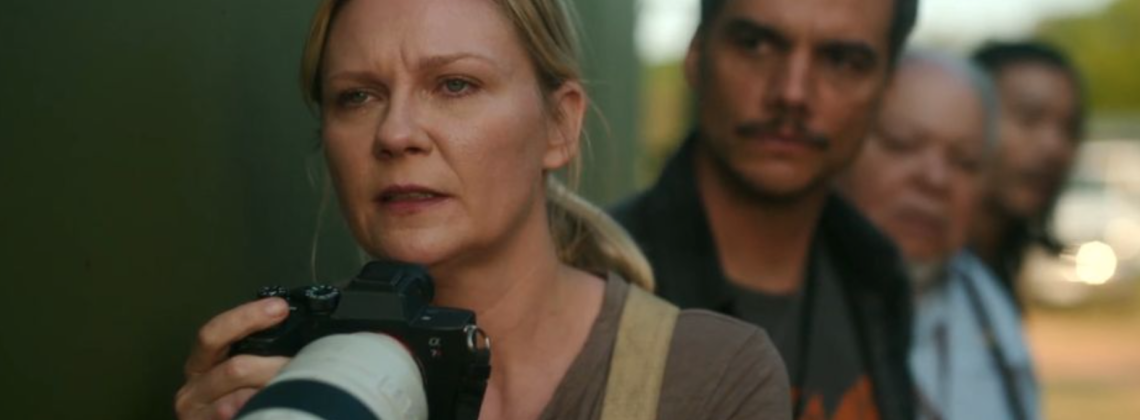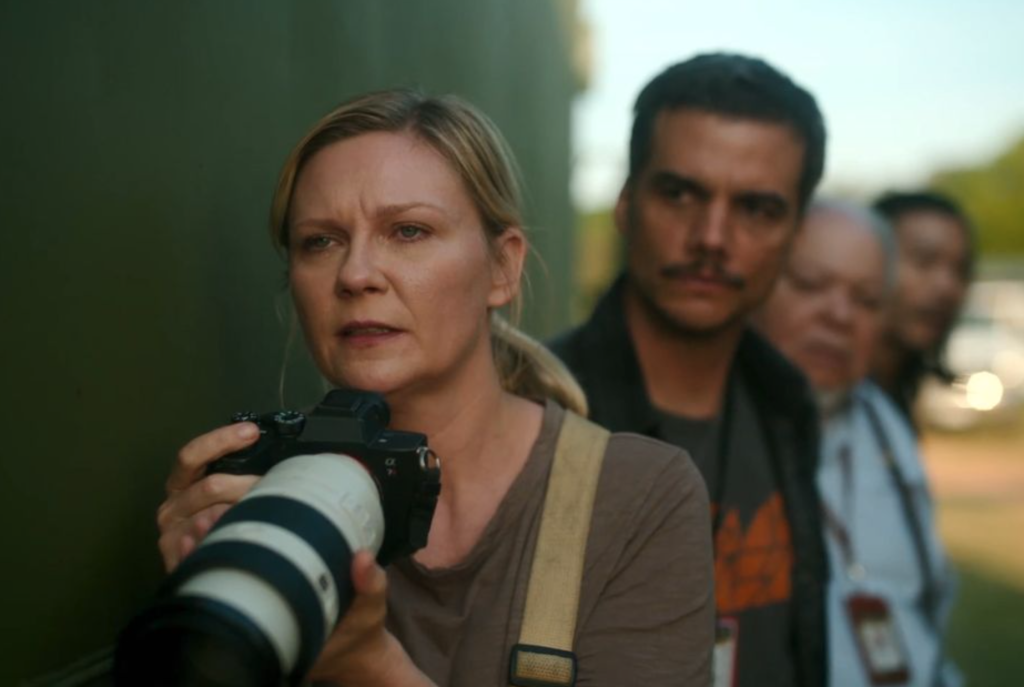

Alex Garland’s film makes the (first) Civil War seem suddenly—and fittingly—near
The British writer and director Alex Garland’s movie is dystopian, dispiriting, bleak, relentless, horrifying, mesmerizing. It’s also a surprising success, reeling in eye-popping box office receipts its opening weekend, at least for an independent film (it’s distributed by A24 in the U.S.).
I will warn you: If you’re a person who can’t bear anything beyond a G rating, this isn’t for you (you already guessed that, as it has “war” in the title). Beyond that certainty, I have no idea how you’ll react. This movie has so many aspects to it: a political context that is at once familiar and mystifying; moments of startling beauty; stunning battle sequences; vignettes and conversations that are unforced and revealing, snapshots of the America landscape and infrastructure that are disorienting, familiar, and that feel like prophecy. It’s a road movie, a coming-of-age-movie, a war movie. I suspect every viewer will come away with a different combination of impressions and a different, highly personal, take on them.
You probably know the basic plot by now; it’s also there in the title. Place: The United States. Time: now. Reasons for the conflict: unknown.
As a war movie it reminds me of Christopher Nolan’s Dunkirk, which was similarly light on politics, preferring to immerse the viewer viscerally into the experience of the event. With Dunkirk, however, the outline (and outcome) of the battle was already well known, and all viewers were familiar with the contestants—which were the good guys, which were the bad.
Civil War is just as immersive—you don’t just watch this movie, you sink into it, a (very scared) passenger along for the ride. But Garland has—wisely in my estimation—chosen not to give us much about the reasons for the conflict. The United States has broken up into several warring sections; there was a January 6th-type event at some point; we hear about “the Antifa massacre” (but aren’t told who was the massacred or who did the massacring). The president is in his third term, has disbanded the FBI, and talks in the prefab patriotic-ese we’ve come to expect at moments of crisis. Washington is besieged by something called the “Western Alliance” made up of California and Texas.
Not only don’t you know—you never know—who are the good and bad guys, you have no idea what the politics of each side are. Was the Constitution amended to keep the president on? Was the FBI disbanded because it was a threat? Or are these actions the threats?
An alliance of California and Texas? In what world? Reviewers have criticized this as implausible, despite the fact that strange alliances are far from rare (the U.S. and the Soviet Union in the 1940s, anyone?). As a tactic to keep the audience unsure and open-minded, it’s brilliant. Garland doesn’t want us “rooting” for whatever side we might sympathize with politically; he wants us identifying with as many characters as possible, merely as humans.
He’s also more than done his homework on civil conflicts and the dynamics of the battlefield experience. When the protagonists (four journalists who want to cover the fall of the U.S. government), are forced to take cover from a sniper, they discover another sniper and his spotter trying to take out the first. When one journalist asks what’s going on, the answer is blunt and spare: Someone in the house is trying to kill us; we’re trying to kill him. One reads over and over again in war memoirs that politics evaporates on the battlefield. Things get very elemental very fast.
A lot of the violence reflects that. A couple of looters are being brutalized by some gas station owners: because they were stealing or because of a grudge? A militia of some kind that may be on one side or the other or simply rogue is nonchalantly disposing of a dozen bodies in a dump-truck. (Here I must single out actor Jesse Plemons for delivering one of the most riveting short performances in recent cinema. If you are familiar with him as a peculiarly sociopathic murderer in Breaking Bad, amplify that considerably for creepiness and believability here.)
One of the problems with battlefield verisimilitude often mentioned by veterans seems to have been largely solved by contemporary technology: the difficulty of replicating just how loud a firefight is. (The other big problems—the smell of various bodily fluids and solids released during battle and the you-can-touch-it fear that envelopes participants—remain thankfully unsolved.) I saw a veteran of Dunkirk interviewed as he was leaving the theater; he said the movie was louder than the actual battle. Similarly here. The movie does not want for decibels, but they are apportioned effectively: brief, unexpected, and terrifying.
François Truffaut once remarked that every close-up in a film is a moral decision for the director. I suspect what he meant was that the near impossibility of not empathizing with someone when their emotions are displayed so prominently makes close-ups a temptation for the director, an easy way of manipulating the audience. Violence, of course, is like that too. As with nudity and sex, violence is hard to look away from; it doesn’t take a lot of auteur-ish sophistication to compel an audience reaction when you shove certain images at them. The sound of the gunshots in this film grabs you, and I’m glad they were used as effectively as they were to drag me into the experience. I’m also glad they were used sparingly.
The photographer-journalist portrayed by Kirsten Dunst says at one point that she thought every story she filed from an overseas conflict was a warning to America: “Don’t do this.” I suppose that’s the lesson of the movie too. But do we need to hear it? Don’t we already know that the U.S. becoming Beirut or Yugoslavia or Rwanda would be a nightmare? Do we need a movie to tell us that? I’m not sure that’s the right question.
Practical people want to know what to do and what not to do. They ask what a piece of art is saying. What does it mean?
But art can work at other levels. Is the Mona Lisa saying anything? Does it have meaning? Or do we value it because it opens up possibilities of sentiment we didn’t know existed in ourselves?
If you’ve seen Ken Burns’ 1990 documentary series about a similar moment in American history, perhaps you felt as I did. The conflict seemed noble: It was elevated by soaring rhetoric, it was righteous in many respects, the good guys won. Most of all it was safe: sepia toned and set to fiddles, it was firmly in the past.
It was also less than two (long) lifetimes ago.
As much as I love Burns’ film, it was still hard to feel the reality of the subject matter. More Americans have been killed by other Americans in one war than were killed by all our foreign enemies in all our other wars put together. If we consider the numbers, Lee and Grant—together or just separately—were far more dangerous to their fellow-countrymen than Osama bin Laden ever was.
It’s not hard to acknowledge that truth theoretically. But it is hard to drive our interstates and feel it. For an hour and a half, Garland makes you believe that, at heart, America’s the same country it was then. That its soul “has never yet melted,” as D. H. Lawrence once put it. It’s no small accomplishment.
John H. Haas teaches U.S. history at Bethel University in Indiana
Very helpful review, Dr Haas. I still don’t know whether or not I want to see this film (the perspective and subject matter interest me a lot, but I fear that the visceral grittiness will be more than I want), but I definitely want to read about this film, and this is the most illuminating piece I have read yet on it.
Thanks Professor Larsen. I can’t tell whether you’ll be glad you saw it or not, if you do. I can tell you that it isn’t gory (by today’s standards), it doesn’t glorify violence or wallow in it, but its matter-of-fact realism makes it all the more unnerving. Also, I’ve read or heard from several people who didn’t exactly “like” it (including my wife, for whom movies such as this are quite the opposite of her cup of tea–she yelped loudly at several points and had her face buried in her hands on a couple occasions–which isn’t that unusual in fact) that they couldn’t stop thinking about it (in a productive way) for days afterwards . Whatever else we might say, that’s quite an achievement. This film isn’t exactly “entertainment.”